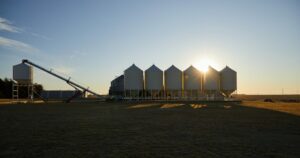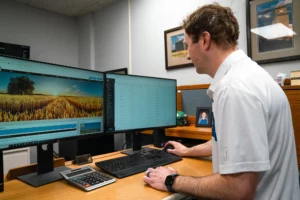Recently, three farmers from across the country came together to share their thoughts about the future of farming during a Bushel Buddy Seat Webinar. They were asked about challenges they are facing, technology, and managing farm data. Throughout the webinar, one thing was clear: regardless of geography, farmers are craving a single tool that helps them manage all of their farm data and that reduces manual or duplicate entry.
Say Goodbye to Paper, Pencils, and Spreadsheets
“There’s gotta be a better way to do this,” said fourth generation Idaho farmer Rylee Reynolds, one of the three farmers serving on the panel for the latest Bushel Buddy Seat Webinar. Reynolds farms about 3,500 acres across 113 different fields, which makes managing crop rotations no easy task. “There’s just gotta be something out there instead of keeping track on pen and paper.”
Just as paper is not a sustainable solution for the long term, other farmers on the panel agreed that neither are spreadsheets. Matt Perreault, an Illinois farmer on the panel, shared his thoughts. “The rules are always changing. I’m always adding in something else I wished was included previously.”
“If I could ever ditch the Excel sheets…there’s my dream,” said Reynolds. “It’s never what I need now, so I’m always tinkering with it.” “We live in a dynamic world, where things are always changing. What made sense a month ago, may not make sense now,” said Max Wenck, a Wisconsin farmer who also served on the webinar panel.
Hello Automation
Given the large volume of data that farmers create and use to manage their farms, automation is imperative to ensuring records are timely, accurate, and easy to gather, organize, and store. “As I’m going through the field, I think about needing to make sure that I’m going back, collecting all these inputs, and documenting where they went,” stated Perreault.
Farmers are very busy, so the more technology can cut down manual entry and human error, the better. “That helps on so many different levels. It would be a dream come true…and the accuracy would go way up because there are days you forget that you did something,” expressed Reynolds.
Another reason farmers would like to see more automation is the challenge of multiple people contributing to the work of one farm. Farming operations come in all shapes, sizes, and levels of comfort with technology. Some people are more hesitant or slower to adopt new technologies. It is not always feasible to depend on others to input all of the data into the right places.
“I’m not always the one that’s operating the equipment, so whatever the acquisition of the data is…it has to be accurate, and it has to be agnostic to who’s operating the equipment. It can’t just be my touch or my knowledge,” Wenck shared.
What’s Next For the Future of Farming?
As far as technology has advanced in a short amount of time, most people would agree that there is always room for improvement and innovation. When asked about the future of farming, this is what Max Wenck had to say:
“When I look into the future of farming over the next 5-10 years, one of the things I see is the emergence of the digital acre.”
Wenck views the“digital acre” as having four key components:
- Finances: Understanding the cost of marketing, and most importantly, margins
- Operations
- Production
- Progress: This may be the factor that’s the most challenging, because it requires the integration of the aspects above.
How Do We Get There?
“I think one of the first steps that would be a great success is to have data that can exist in the same place,” expressed Wenck.
Perreault agreed: “Long term, if you could have everybody on the same platform, and that data just automatically pushed into a software platform that tracked all that. That would be the end goal.”
The dream would be cloud-based software that could seamlessly sync among equipment, mobile phones, and computers, to record everything from field activities to inputs, yields, and profit/loss. There is an opportunity to take chaos and harness it into easily digestible information.
With equipment today, a lot of data can be acquired from a production standpoint. “What has been missing is the ability to seamlessly integrate that data so that we can start to look at the progress and the performance of it.”
In order to get all of that data in the same place, there are several factors that need to be considered:
Collaboration/Integration
In order to have one platform that can centralize farm data, there needs to be integration among equipment manufacturers, grain companies (and their ERPs), ag retailers, and software companies.
Standardization of Data
Should all farm data eventually flow into one place, uniformly formatting and consistently organizing that data will be essential. Computer systems must be able to communicate with one another and exchange data. Standardization will also make it easier to process and analyze data and store it in a database. As a result, farmers will be able to make better decisions, comparing and analyzing data and using insights to improve their operations.
Key Takeaways:
Future-thinking farmers are ready to adopt technology that better serves their needs. What do they hope technology will achieve in the coming years? A platform that can centralize their farm data and generate insights that help them improve their operations, without the pain of manual entry. To make this a reality, agribusinesses need to work together to standardize and consolidate farm data.
To watch the full recording of the Farmer of the Future webinar, visit www.buddyseat.com.



